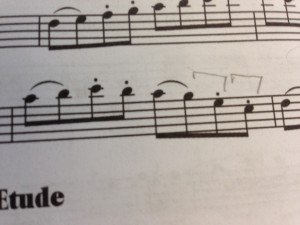Miss It? Mark It! Part 3 (pencil marks)
- Marlene
- Blog, flute, Uncategorized
- 2 Comments
Miss It? Mark It! Part 3 (pencil marks)
Adding pencil marks to music are effective in helping learn new material. But exactly what parts should be marked and what symbols are helpful?
If a mistake happens consistently, try to figure out why the brain is having trouble. When we know what the error is, we can be creative about finding a solution. One way to fix errors is to make pencil marks in the music. In “Miss It? Mark It! Part 1” I talked about adding color; in part 2 I showed an example of a student’s use of reminder sharps. Today I helped a student whose fingers had a mind of their own.
I added the pencil brackets to this tricky passage from Addie’s* music:
Most of the rest of the etude involved stepwise motion (up and down a scale). However, in this measure there are two skips. Addie’s fingers wanted to play the last four notes as A-G-F-E. By adding the brackets above the notes that skip, her eye was drawn to this spot earlier.
Pencil marks, if used properly, can become little flashing lights, telling us to pay special attention.
The brackets are my shorthand for “not stepwise” or “skips.” I use this symbol (^) for notes that move stepwise among skips. I know the brackets and ^ also indicate bow directions for string players, but flute players don’t seem to mind. If you’re a string player, you may want to develop your own symbols for “steps” and “skips.”
It doesn’t matter what marks you use as long as they fix the problem. Work out a system and use it consistently. Happy practicing!

2 comments